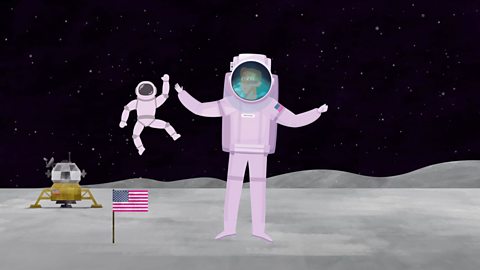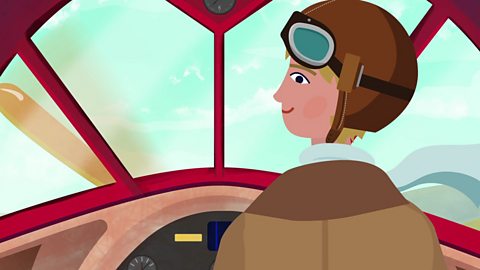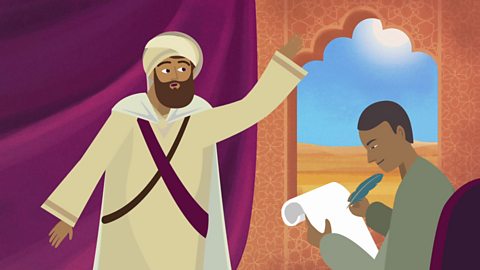FATIMA: Who shall we look up today?
OLLIE: Let’s go way back, way back in time.
FATIMA: Okay, that sounds good.
OLLIE: Who discovered America?
FATIMA: You mean who was the first person from Europe to go there?
OLLIE: Yeah.
FATIMA: Let’s find out. Holo-Lab, who was the first person from Europe to go to America?
HOLO-LAB: Searching. Searching… Found. First person from Europe to go to America, Christopher Columbus.
OLLIE: Wow! We’re going far, far back in time.
FATIMA: It’s 1492.
OLLIE: Whoa!
FATIMA: Hi, Christopher. I’m Fatima and this is Ollie.
OLLIE: Hi there.
CHRISTOPHER COLOMBUS: Ciao! I am the great Christopher Columbus, Master of the Seas. I persuaded the noble Queen Isabella and King Ferdinand of Spain to pay for my search for a westward route to the East Indies.
FATIMA: Where are the East Indies and why did you want to go there?
CHRISTOPHER COLOMBUS: They are the lands to the south and east of India. I wanted to bring back the valuable silks and spices.
OLLIE: So you were hopeful you would reach America?
CHRISTOPHER COLOMBUS: America? No. I thought I was travelling to Asia. I calculated it was 3,700 kilometres from the Canary Islands to the East Indies, so I thought that it might be quicker to sail there by going west, by sailing round the world.
FATIMA: Maybe I can help. Let’s look at a globe. Holo-Lab, show globe.
CHRISTOPHER COLOMBUS: I knew the world was round, but I thought it was smaller. I didn’t know a whole other continent would be in my way so rather than finding a faster route to Asia, I discovered a new world full of amazing animals and civilisations as Europeans had never met before. Can your magical box see where I first reached land?
FATIMA: Please show us, Holo-Lab. So you set off with no idea if you would make it?
CHRISTOPHER COLOMBUS: Yes. It was very uncertain where we would end up or if we would even survive. I did it for the glory of Genoa, where I’m from. For my patrons in Spain, for the Lord God Almighty and perhaps even a little bit for the glory of me.
OLLIE: What was the voyage like?
CHRISTOPHER COLOMBUS: Conditions were harsh. We had to ration food and water because we didn’t know how long we’d be at sea.
FATIMA: If you didn’t know where you were going, how did you know how to get there?
CHRISTOPHER COLOMBUS: I had learned from the Portuguese about the trade winds. The easterlies to the south that would carry me across the Atlantic and the westerlies to the north that would carry me back. I also used the Sun and the stars to guide my ship.
OLLIE: Wasn’t it dangerous, not knowing precisely where you were going?
CHRISTOPHER COLOMBUS: It was very dangerous but sailing anywhere then, especially over long distances was very dangerous. Many sailors were killed by storms, lack of food or water, or terrible diseases. But I trusted in God to deliver me.
FATIMA: You must’ve been very happy when you got home.
CHRISTOPHER COLOMBUS: I was, but I was in love with adventure. I made four trips between Spain and the Americas, between 1492 and 1503. Life can be very scary sometimes but if we dare to be brave and face our fears, we can discover new lands, things we never knew existed.
OLLIE: Wow!
FATIMA: Thank you very much for talking to us, Christopher Columbus.
CHRISTOPHER COLOMBUS: Thank you for showing me something new too. Ciao!
Video summary
This short animated film for primary pupils takes a look at Christopher Columbus' epic adventures to the Americas.
It introduces the geographical skills of reading maps, using globes and understanding the points of the compass, as well as place knowledge of North and South America and Europe.
This short film is from the 91»»±¨ series, Explorers.
Teacher Notes
This short film could be used alone as an introduction to a topic based around Christopher Columbus and his journey, or it could be used alongside one or more of the other Explorers films, comparing different explorers and their experiences, and looking at the changes in travel and exploration over time.
This film provides lots of scope for learning in geography:
- Pupils could look at a globe and highlight where Columbus thought he was going, and where he actually ended up.
- They could look at maps of North, Central and South America, and plot Columbus’ journey on a world map, marking the equator, tropics of Cancer and Capricorn, Northern and Southern hemispheres, and lines of longitude and latitude.
- After watching the film you could discuss the eight points of a compass and how compasses and lines of longitude and latitude would be used to navigate.
- This film could be the starting point for further study of North and South America, comparing the geography of the countries Columbus discovered to the geography of the country he left behind.
- You could also compare the flora, fauna, climates and biomes of the Americas to those of Europe.
In a link with history, they could investigate some of the items that Columbus introduced to America (e.g. horses) and some of the things he brought back with him (e.g. pineapples).
In English, this film could inspire first personal recounts in the style of a ships log:
- Pupils could write in character as Columbus, describing the strange and wonderful things he encountered when he arrived in the Bahamas.
- They could write adventure stories about imaginary explorers discovering new lands.
- They could learn about the power of descriptive language, writing descriptions of new landscapes for people back home.
Your pupils could use their maths skills to calculate the distances traveled by Columbus and the length of time his journey took him.
They could work how much food of different types the crew would have had to take with them to last their journey.
For art and design, you could look at the painting by Dioscoro Puebla called Desembarco de Colon and create your own pictures of an explorer arriving in a new land.
In music lessons, you could listen to Wagner's "Columbus Overture" and Philip Glass's "The Voyage" and compare how different composers, 150 years apart, have been inspired by Columbus's journey. You could have a go a composing your own short pieces of music on the theme of exploration.
This short film could be used to study a variety of cross-curricular topics at KS2 in England, Wales and Northern Ireland and 2nd Level in Scotland. Including;
- Maths
- Geography
- English
- History
- Art and design
- Music
More from Explorers
Neil Armstrong. video
Neil Armstrong's historic voyage to the Moon is explored in this short animated film for primary pupils.

Robert Falcon Scott. video
Robert Falcon Scott's ill-fated journey to the South Pole is brought to life in this short animated film for primary pupils.

Amelia Earhart. video
The life of Amelia Earhart, a courageous pilot who broke records in the air, is introduced to primary pupils in this short animated film.

Ibn Battuta. video
Through Ibn Battuta's epic 29-year journey, primary pupils can explore core learning topics such as creative writing, pilgrimage, Hajj and early Islamic civilisation.
